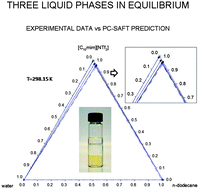Measurement and PC-SAFT modelling of three-phase behaviour†
Abstract
Modelling of multi-component systems with complex interactions is an ongoing challenge in thermodynamics due to their great relevance in industry and academia. Systems that build three liquid phases are found in many interesting applications (separation processes, triphasic catalysis…). Among them, the surfactant flooding method for enhanced oil recovery is noticeable. In this method, a stable solution of water, surfactants, co-surfactants, salts and other components is injected into the reservoir. The optimal formulation of this surfactant system is associated with a three-phase behaviour in which the interfacial tension becomes significantly low. In this work, the PC-SAFT equation of state was used for the first time to predict the equilibrium involved in triphasic systems using solely pure-component parameters. The model without any fitting parameter was able to predict the three-phase behaviour. A great agreement between experimental and predicted compositions for (water + [C10mim][NTf2] + n-dodecane) and (water + [C12mim][NTf2] + n-dodecane) ternary systems at 298.15 K and atmospheric pressure was found. At 348.15 K slightly higher deviations were found, which can be compensated by the introduction of just one binary interaction parameter. The success of this achievement could mean an important advancement in upstream oil operations, enabling a faster and cheaper method to carry out an initial screening of potential surfactants.


 Please wait while we load your content...
Please wait while we load your content...